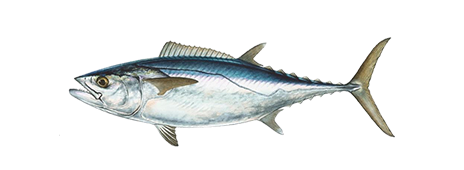Dogtooth Tuna

Dogtooth tuna are known to be excellent both as a sport fish and as table fare.
HOW TO IDENTIFY A DOGTOOTH TUNA
The dogtooth tuna is noted for its lack of scales (except on the corselet and along either side of the lateral line) and for its large conical teeth; features which have given this fish its namesake. It is actually a member of the bonito family. The first dorsal fin has 13-15 spines; the second is higher and has 12-14 rays followed by 6-7 dorsal finlets. The anal fin has 12-13 rays and there are 11-14 gill rakers on the first arch. The lateral line is prominent and wavy, ending in a keel on the caudal peduncle. It is the only bonito that has a swim bladder and a large, single interpelvic process. There are no dark stripes or spots on the body. The second dorsal and anal fins are tipped with white.
WHERE TO CATCH DOGTOOTH TUNA
The dogtooth tuna inhabits tropical and subtropical areas of the Indian and Pacific Oceans around coral reefs. It has been taken in the Red Sea and sporadically in southern Japanese waters as well as around Papua New Guinea, the Marshall Islands, the Society Islands, the Marquesas Islands and from East Africa to Australia. It is a pelagic and migratory species, but is known to enter inshore waters during the warm season.It is usually found around coral reefs, channels, passes or rocky areas, where it feeds extensively on reef fish. The following list includes additional details on where to catch this fish:
BAITFISH PATCHES DEEP SHORE WATER
REEFS, WRECKS, AND SHOALS COASTAL WATERS
NIGHT FISHING ROCKY SEA FLOOR
HOW TO CATCH DOGTOOTH TUNA
Tunas and most bonitos feed more often on pelagic, schooling fishes, but no tuna or bonito feeds exclusively on any one type of prey. The dogtooth will readily consume a smaller mackerel, squid or other pelagic fish.When hooked the first run of a dogtooth tuna is fast and long and is followed by a deep, circling, and tough fight. It is usually taken incidentally while deep trolling or deep live or dead bait fishing for other species in the vicinity of an offshore reef, though some are caught on rigs trolled on or near the surface. Anglers who specifically target dogtooth tunas will typically target them using heavy vertical jigs. This fish has been known to take mackerel, mullet, squid, strip baits, spoons, plugs, feathers, and plastic lures. The following are fishing methods used to catch this fish:
DRIFT FISHING SALTWATER TROLLING
BOTTOM BOUNCING SALTWATER JIGGING
DOGTOOTH TUNA LURES, TACKLE & BAIT
The following are lures, tackle or bait that can be used to catch this fish:
CUT BAIT SALTWATER LIVE BAIT
TROLLING LURES JIGS
SQUID